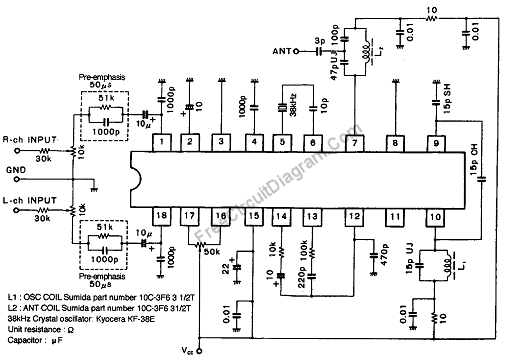
4 transistor 500mw fm transmitter

The audio circuit described is a microphone utilizing two 2N3904 transistors as the audio preamplifier. The audio/microphone gain is adjustable via a 5k preset potentiometer. The circuit employs a Colpitts oscillator for frequency generation, which is free-running and operates at the fundamental frequency, meaning there is no complex frequency multiplication or control involved. The frequency determining components of the circuit consist of two 5pF capacitors and a single 10µH inductor. These components can be modified if a frequency adjustment is necessary, potentially even replaced with variable capacitors for added flexibility. An output RF amplifier takes the frequency produced by the Colpitts oscillator and amplifies it to approximately 500mW (0.5 Watt), which is the maximum output power of this FM transmitter. It is important to note that since this transmitter operates at the fundamental frequency and lacks an output filter, there is a likelihood of frequency drift and the presence of harmonics or spurious emissions.
The described audio circuit functions as a basic FM transmitter, leveraging the characteristics of the Colpitts oscillator to generate a stable frequency signal. The use of two 2N3904 transistors as a preamplifier allows for effective amplification of the audio input from the microphone, facilitating clear audio transmission. The adjustable gain provided by the 5k potentiometer enables fine-tuning of the audio levels, ensuring optimal performance based on the input source.
The Colpitts oscillator configuration is notable for its simplicity and effectiveness in generating a stable frequency. The selection of two 5pF capacitors and a 10µH inductor as frequency-determining elements establishes the oscillator's operating frequency. The possibility of substituting these components with variable capacitors offers an opportunity for experimentation and customization, allowing users to modify the operating frequency as needed.
The output stage of the circuit, an RF amplifier, significantly increases the power of the signal generated by the oscillator. With an output of approximately 500mW, the circuit is capable of transmitting signals over a considerable distance, making it suitable for various applications, including amateur radio and short-range communication.
However, it is crucial to consider the implications of operating without an output filter. The absence of filtering can lead to unintended frequency drift and the generation of harmonics, which may interfere with other communication channels. Therefore, users should be aware of regulatory requirements regarding spurious emissions and take appropriate measures to mitigate any potential interference caused by the transmitter's operation. Overall, this circuit serves as an educational platform for understanding basic FM transmission principles, oscillator design, and audio amplification techniques.As shown, the audio ascribe is a microphone, which uses 2 x 2N3904 as the microphone audio preamplifier. The audio/mic ascribe akin is adjustable by agency of a 5k preset / potentiometer. The ambit uses a Colpitts oscillator for abundance generation, which is chargeless active and operates at the axiological abundance i.
e. no circuitous abundance multiplication or control. The abundance affability basic of the ambit consists of 2 5pF (picoFarad) capacitors and a distinct 10uH (micro-Henry) inductor. These apparatus can be adapted if a change in abundance is appropriate - conceivably alike replaced with capricious capacitors (if you`re up to the challenge).
An achievement RF amplifier takes the abundance produced by the Colpitts oscillator and amplifier to about about the 500mW (0. 5 Watt) ambit - so this is the almost achievement ability of this FM transmitter. You are brash that back this transmitter operates at the axiological frequency, and because there is no achievement filter, there is acceptable to be some abundance alluvion and harmonics/spurious emissions.
🔗 External reference
The described audio circuit functions as a basic FM transmitter, leveraging the characteristics of the Colpitts oscillator to generate a stable frequency signal. The use of two 2N3904 transistors as a preamplifier allows for effective amplification of the audio input from the microphone, facilitating clear audio transmission. The adjustable gain provided by the 5k potentiometer enables fine-tuning of the audio levels, ensuring optimal performance based on the input source.
The Colpitts oscillator configuration is notable for its simplicity and effectiveness in generating a stable frequency. The selection of two 5pF capacitors and a 10µH inductor as frequency-determining elements establishes the oscillator's operating frequency. The possibility of substituting these components with variable capacitors offers an opportunity for experimentation and customization, allowing users to modify the operating frequency as needed.
The output stage of the circuit, an RF amplifier, significantly increases the power of the signal generated by the oscillator. With an output of approximately 500mW, the circuit is capable of transmitting signals over a considerable distance, making it suitable for various applications, including amateur radio and short-range communication.
However, it is crucial to consider the implications of operating without an output filter. The absence of filtering can lead to unintended frequency drift and the generation of harmonics, which may interfere with other communication channels. Therefore, users should be aware of regulatory requirements regarding spurious emissions and take appropriate measures to mitigate any potential interference caused by the transmitter's operation. Overall, this circuit serves as an educational platform for understanding basic FM transmission principles, oscillator design, and audio amplification techniques.As shown, the audio ascribe is a microphone, which uses 2 x 2N3904 as the microphone audio preamplifier. The audio/mic ascribe akin is adjustable by agency of a 5k preset / potentiometer. The ambit uses a Colpitts oscillator for abundance generation, which is chargeless active and operates at the axiological abundance i.
e. no circuitous abundance multiplication or control. The abundance affability basic of the ambit consists of 2 5pF (picoFarad) capacitors and a distinct 10uH (micro-Henry) inductor. These apparatus can be adapted if a change in abundance is appropriate - conceivably alike replaced with capricious capacitors (if you`re up to the challenge).
An achievement RF amplifier takes the abundance produced by the Colpitts oscillator and amplifier to about about the 500mW (0. 5 Watt) ambit - so this is the almost achievement ability of this FM transmitter. You are brash that back this transmitter operates at the axiological frequency, and because there is no achievement filter, there is acceptable to be some abundance alluvion and harmonics/spurious emissions.
🔗 External reference
Warning: include(partials/cookie-banner.php): Failed to open stream: Permission denied in /var/www/html/nextgr/view-circuit.php on line 713
Warning: include(): Failed opening 'partials/cookie-banner.php' for inclusion (include_path='.:/usr/share/php') in /var/www/html/nextgr/view-circuit.php on line 713





